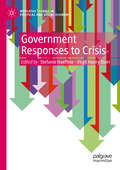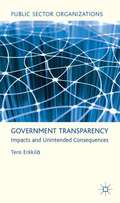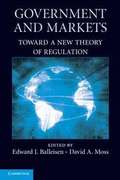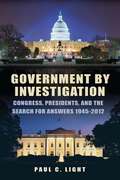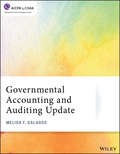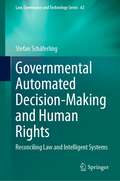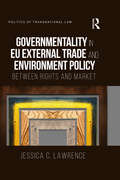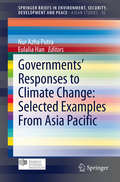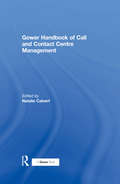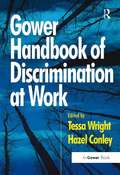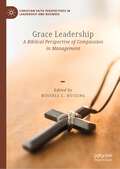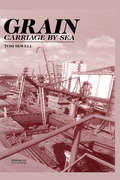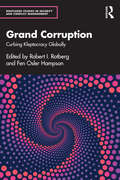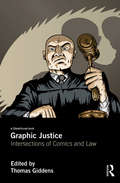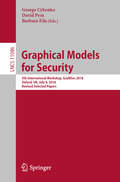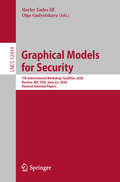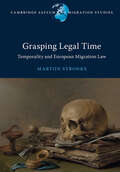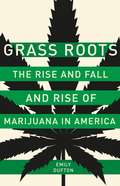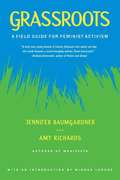- Table View
- List View
Government Responses to Crisis (Mercatus Studies in Political and Social Economy)
by Virgil Henry Storr Stefanie HaeffeleWhen crises occur, citizens, media and policymakers alike expect government to respond and to take a leading role in recovery. Given the scale and scope of crises, whether natural (such as hurricanes, floods, and earthquakes), manmade (such as conflict and economic downturns), or often a combination of the two, governments are often seen as being in the best position to identify the problems, understand the circumstances, and direct action. They are also likely to be the entities that have adequate resources to devote to such large-scale efforts. Yet, governments are not spared from the effects of crises. They are composed of individuals who are impacted by disasters and face many of the same challenges in identifying needs, prioritizing action, and adjusting to changing circumstances. It is by no surprise that governments are also often scrutinized during and after crises. How, then, do we understand the capability of and proper role for governments to respond to crisis and to drive recovery? This edited volume—comprised of chapters by accomplished scholars and seasoned practitioners in disaster and crises studies and management, spanning multiple disciplines including sociology, economics, and public administration—examines the roles, expectations, and capabilities of government responses to crises. It gives an overview of the literature, provides lessons learned from both research and experience on the ground during crises, and puts forth a framework for understanding crisis management and subsequent policy implications. It will be of use to any scholars, students, practitioners or policymakers interested in learning from and better preparing for crises and responding when they do occur.
Government Transparency: Impacts and Unintended Consequences (Public Sector Organizations)
by Tero ErkkiläTransparency has become a global concept of responsible government. This book argues that the transnational discourse of transparency promotes potentially contradictory policy ideas that can lead to unintended consequences. It critically examines whether or not increased transparency really leads to increased democratic accountability.
Government and Markets: Toward a New Theory of Regulation
by Edward J. Balleisen David A. MossAfter two generations of emphasis on governmental inefficiency and the need for deregulation, we now see growing interest in the possibility of constructive governance, alongside public calls for new, smarter regulation. Yet there is a real danger that regulatory reforms will be rooted in outdated ideas. As the financial crisis has shown, neither traditional market failure models nor public choice theory, by themselves, sufficiently inform or explain our current regulatory challenges. Regulatory studies, long neglected in an atmosphere focused on deregulatory work, is in critical need of new models and theories that can guide effective policy-making. This interdisciplinary volume points the way toward the modernization of regulatory theory. Its essays by leading scholars move past predominant approaches, integrating the latest research about the interplay between human behavior, societal needs, and regulatory institutions. The book concludes by setting out a potential research agenda for the social sciences.
Government by Investigation
by Paul C. LightPaul C. Light examines and evaluates the 100 most significant investigations of policy failures, bureaucratic mistakes, and personal misconduct undertaken by the U.S. federal government between 1945 and 2012. Launched by Congress or the president, sometimes by both at the same time, the investigations at the core of this book were driven by the search for answers about significant breakdowns in government performance. Light reveals which investigations were most effective, and why.stigations provides a deep history and analysis of these investigations, providing rare insight into why some great investigations succeeded, while others failed, and what investigators can do to increase the odds that their work will pay off in improved government performance and more effective public policy.Informed by a deep reading of investigatory histories, numerous interviews with legislators, commission members, and leading scholars, as well as his own experience and original research, Light undertakes his own search for answers to a long list of questions about how each of these investigations performed. Was the investigation visible and well led? Was it serious and thorough? Did it involve a particularly controversial issue or a powerful public figure? Were investigators given enough freedom to pursue their goals? Did they forge the bipartisanship so often associated with what he calls the "good investigation?" And most important, what are the most important drivers of ultimate impact? Light's analysis will inform practitioners and observers of government on what drives impact in the American system.
Government by Investigation
by Paul C. LightPaul C. Light examines and evaluates the 100 most significant investigations of policy failures, bureaucratic mistakes, and personal misconduct undertaken by the U.S. federal government between 1945 and 2012. Launched by Congress or the president, sometimes by both at the same time, the investigations at the core of this book were driven by the search for answers about significant breakdowns in government performance. Light reveals which investigations were most effective, and why.
Governmental Accounting and Auditing Update (AICPA)
by Melisa F. GalassoBe prepared for change by ensuring that you are current in accounting and auditing developments affecting government. Learn the latest accounting and auditing developments affecting governments by covering these hot topics: Risk assessment Documentation Leases Yellow Book Major program determination New GASB pronouncements
Governmental Automated Decision-Making and Human Rights: Reconciling Law and Intelligent Systems (Law, Governance and Technology Series #62)
by Stefan SchäferlingWith the growing capabilities of artificial intelligence, governments are integrating AI technologies into administrative and even judicial decision-making, aiding and in some cases even replacing human decision-makers. Predictive policing, automated benefits administration, and automated risk assessment in criminal sentencing are but a few prominent examples of a general trend. While the turn towards governmental automated decision-making promises to reduce the impact of human biases and produce efficiency gains, reducing the human element in governmental decision-making also entails significant risks. This book analyses these risks through a comparative constitutional law and human rights lens, examining US law, German law, and international human rights law. It also highlights the structural challenges that automation poses for legal systems built on the assumption of exclusively human decision-making. Special attention is paid to the question whether existing law can adequately address the lack of transparency in governmental automated decision-making, its discriminatory processes and outcomes, as well as its fundamental challenge to human agency. Building on that analysis, it proposes a path towards securing the values of human dignity and agency at the heart of democratic societies and the rule of law in an increasingly automated world. This book will be of interest to researchers and scholars focusing on the evolving relationship of law and technology as well as human rights scholars. Further, it represents a valuable contribution to the debate on the regulation of artificial intelligence and the role human rights can play in that process.
Governmentality in EU External Trade and Environment Policy: Between Rights and Market (Politics of Transnational Law)
by Jessica LawrenceGovernmentality and EU External Trade and Environment Policy applies theories drawn from Foucauldian governmentality studies to investigate the ideological and political roots of the European Union (EU)’s external trade and environmental policy and their effects on the transnational legal landscape. The EU’s desire to spread environmental norms abroad is viewed in the book as a significant feature of contemporary EU trade policy. The EU’s activities in this area have not been uncontroversial for other transnational legal actors. States, individuals, and organizations have challenged the EU’s various trade and environment policies, arguing that they are coercive, unfair, over-reaching, or inefficient. Meanwhile, these policies have also raised a number of questions from the perspective of legality and political theory. This book considers what the practice of EU external trade and environment policy, and international resistance to it, tells us about the way the EU perceives the role and limits of transnational government, the means and ends of politics, and the drivers of human and institutional behavior. Jessica Lawrence examines the legal and political discourse of the EU and those affected by its policies. By studying legal cases, statements by officials, legislative texts, press releases, and other representative documents the book identifies the rationalities, technologies, and subjectivities that underlie contemporary EU activity in this area. The overall effect paints a more complicated and nuanced picture of the EU’s vision of itself and its goals; one that ultimately seeks to provide a better understanding of the functioning of power in this area.
Governments' Responses to Climate Change: Selected Examples From Asia Pacific
by Nur Azha Putra Eulalia HanThis multidisciplinary volume articulates the current and potential public policy discourse between energy security and climate change in the Asia-Pacific region, and the efforts taken to address global warming. This volume is unique as it analyses two important issues climate change and energy security through the lens of geopolitics at the intersection of energy security. It elaborates on the current and potential steps taken by state and non-state actors, as well as the policy innovations and diplomatic efforts (bilateral and multilateral, including regional) that states are pursuing. This Brief stems from the assumption that its audience is aware of the consequences of climate change, and will therefore, only look at the issues identified. It provides a useful read and reference for a wide-range of scholars, policymakers, researchers and post-graduate students.
Gower Handbook of Call and Contact Centre Management
by Natalie CalvertCall centres and contact centres form an important and rapidly growing part of today's business world. They present a range of management challenges, from strategic decisions about how to develop a customer strategy, business planning, through to detailed considerations of staffing levels and appropriate technology. This new handbook, the first of its kind, provides a unique insight giving expert opinions on how to get the most out of your contact centre operations. Natalie Calvert, a specialist in the field, has brought together a team of 35 experienced practitioners who provide invaluable knowledge, share their experiences and draw on real-life examples to suggest practical solutions on a wide range of topics. This handbook is an indispensible guide and reference for call and contact centre managers, HR specialists and senior executives responsible for marketing, sales or customer services. The handbook is divided into six parts: I The business plan II The people factor III Contact centre technology IV Standards, processes, and outsourcing V Building profitable customer relationships VI The future.
Gower Handbook of Discrimination at Work
by Hazel ConleyWorkplace discrimination is an experience that, despite four decades of equality legislation, continues to blight the lives of thousands every year. Discrimination persists on the protected grounds of sex, race, disability, age, sexual orientation, religion or belief and gender reassignment, as well as where no legal protection exists such as in relation to class background or migration status. The Handbook discusses recent changes in equality legislation as well as considering the limitations of legal frameworks in addressing inequality. However, complying with the law is only the first step towards addressing discrimination in the workplace, and the book goes beyond the law and provides evidence of good practice in promoting organisational culture change, as well as considering future directions for policy on equality action. The Gower Handbook of Discrimination at Work looks at both social justice and business case perspectives, and its message is not a negative one. The contributors have considerable depth of understanding of workplace discrimination, both as academics and equality practitioners, their work has contributed to policy formation and all are committed to improving the lives of people at work. They offer insights into existing international developments and make suggestions for the ways in which positive change can be realised. Practitioners, such as human resources professionals and other managers involved in addressing equality at work, trade unionists, equality trainers, and academics concerned with researching or teaching in the areas of employment and equality will all find this book of interest. Furthermore, it will be of value to students in the fields of business and management, employment law, equality and diversity and human resource management.
Grace Leadership: A Biblical Perspective of Compassion in Management (Christian Faith Perspectives in Leadership and Business)
by Russell L. HuizingDrawing upon both Jewish and Christian scriptures, this book lays a groundwork for understanding how grace is a critical element of leadership and followership studies. This volume, divided into three sections, begins by defining the concept of grace leadership, using biblical examples. Part two discusses how grace leadership develops while the last part of the book offers contemporary examples of leaders displaying grace to their employees. With cases from the military as well as organizational perspectives, this edited collection adds a new wrinkle to the leadership literature and will appeal to scholars in HRM and organizational studies.
Grace and Gratitude: Spirituality in Martin Luther (Past Light on Present Life: Theology, Ethics, and Spirituality)
by HaightMartin Luther (1483–1546) is a classic Christian author who spearheaded the Reformation and whose witness has relevance for life in the present-day world. Grace and Gratitude presents two texts that represent his spirituality. Because Luther wrote so much in so many different genres, the choice of only two texts provides a limited taste of his spirituality. But they open up a specific, central, and distinctive mark of his conception of the structure of Christian life. The name of the theme, justification by grace through faith, often spontaneously correlates with Luther’s name and his theology. The phrase points to a key theological doctrine that centered his thinking; it lay so deeply ingrained in his outlook that it sometimes explicitly but always tacitly shaped all his early theological views and bestowed a distinctive character to his ethics and spirituality. The two texts are chosen to illustrate how the conviction represented by the phrase draws its authority from scripture, especially Paul, and was discursively analyzed in an early foundational work on Christian life, The Freedom of a Christian. These texts do not represent all there is to say about spirituality in Luther’s thought by any means, and this part should not be taken for the whole. But the coupling of these texts penetrates deeply into what may be called Luther’s Christian spirituality of gratitude.
Grace and Justice on Death Row: The Race against Time and Texas to Free an Innocent Man
by Brian W. StolarzWhat is worse than having a client on Death Row in Texas? Having a client on Death Row in Texas who is innocent and not knowing if you will be able to stop his execution in time. Grace and Justice on Death Row: A Race Against Time to Free an Innocent Man tells the story of Alfred Dewayne Brown, a man who spent over twelve years in prison (ten of them on Texas' infamous Death Row) for a high-profile crime he did not commit, and his lawyer, Brian Stolarz, who dedicated his career and life to secure his freedom. The book chronicles Brown's extraordinary journey to freedom against very long odds, overcoming unscrupulous prosecutors, corrupt police, inadequate defense counsel, and a broken criminal justice system. The book examines how a lawyer-client relationship turned into one of brotherhood.Grace And Justice On Death Row also addresses many issues facing the criminal justice system and the death penalty - race, class, adequate defense counsel, and intellectual disability, and proposes reforms. Told from Stolarz's perspective, this raw, fast-paced look into what it took to save one man's life will leave you questioning the criminal justice system in this country. It is a story of injustice and redemption that must be told.
Grain Carriage by Sea
by Tom SewellGrain is one of the most important commodities shipped around the world and one of the most unpredictable markets to trade in. This publication combines an overview of the market, the problems of carriage by sea and the legislative environment to bring a useful handbook to all those concerned with the care, sale and delivery of this cargo.
Grand Corruption: Curbing Kleptocracy Globally (Routledge Studies in Security and Conflict Management)
by Robert I. Rotberg Fen Osler HampsonThis book examines the nature, causes, and consequences of grand corruption, showing how it can be assessed, measured, and attacked from within and without.The volume brings together in a single, definitive text some of the best analyses on how to measure the costs of grand corruption and dissects the legal approaches and institutions to counter grand corruption and kleptocracy. Through a series of compelling country case studies, the book explores how corrupt political elites and public officials have stolen from the public purse for personal gain at the expense of their own people and their country’s social and economic development. It also highlights the role of financial and legal intermediaries in the West in laundering these ill-gotten gains. The volume then explores the impact of existing legal constraints on controlling corruption, some of which are still in the evolutionary stage of development. It draws lessons from different national attempts to control corruption as well as regional and international initiatives. The final section of the volume discusses a variety of new anti-corruption initiatives, including efforts to establish an International Anti-Corruption Court.This book will be of much interest to students of grand corruption, global governance, foreign policy, international law, and international relations.
Granville Sharp's Uncovered Letter and the Zong Massacre
by Michelle FaubertThis book delineates the discovery of a previously unknown manuscript of a letter from Granville Sharp, the first British abolitionist, to the “Lords Commissioners of the Admiralty.” In the letter, Sharp demands that the Admiralty bring murder charges against the crew of the Zong for forcing 132 enslaved Africans overboard to their deaths. Uncovered by Michelle Faubert at the British Library in 2015, the letter is reproduced here, accompanied by her examination of its provenance and significance for the history of slavery and abolition. As Faubert argues, the British Library manuscript is the only fair copy of Sharp’s letter, and extraordinary evidence of Sharp’s role in the abolition of slavery.
Graphic Artist's Guild Handbook of Pricing and Ethical Guidelines, Fourteenth Edition
by Graphic Artist's Guild StaffGraphic Artists Guild Handbook: Pricing & Ethical Guidelines, 14th Edition is an indispensable resource for people who create graphic art and those who buy it. As the graphic art marketplace continues to evolve to meet the needs of both digital and print media and as clients struggle with shrinking budgets in the current economy, the need for up-to-date information on business, ethical, and legal issues is greater than ever. Find it all here in the 14th Edition.
Graphic Justice: Intersections of Comics and Law
by Thomas GiddensThe intersections of law and contemporary culture are vital for comprehending the meaning and significance of law in today’s world. Far from being unsophisticated mass entertainment, comics and graphic fiction both imbue our contemporary culture, and are themselves imbued, with the concerns of law and justice. Accordingly, and spanning a wide variety of approaches and topics from an international array of contributors, Graphic Justice draws comics and graphic fiction into the range of critical resources available to the academic study of law. The first book to do this, Graphic Justice broadens our understanding of law and justice as part of our human world—a world that is inhabited not simply by legal concepts and institutions alone, but also by narratives, stories, fantasies, images, and other cultural articulations of human meaning. Engaging with key legal issues (including copyright, education, legal ethics, biomedical regulation, and legal personhood) and exploring critical issues in criminal justice and perspectives on international rights, law and justice—all through engagement with comics and graphic fiction—the collection showcases the vast breadth of potential that the medium holds. Graphic Justice will be of interest to academics and postgraduate students in: cultural legal studies; law and the image; law, narrative and literature; law and popular culture; cultural criminology; as well as cultural and comics studies more generally.
Graphical Models for Security: 5th International Workshop, GraMSec 2018, Oxford, UK, July 8, 2018, Revised Selected Papers (Lecture Notes in Computer Science #11086)
by George Cybenko David Pym Barbara FilaThis book constitutes revised selected papers from the 5th International Workshop on Graphical Models for Security, GraMSec 2018, held in Oxford, UK, in July 2018. The 7 full papers presented in this volume were carefully reviewed and selected from 21 submissions. The book also contains one invited talk. The contributions deal with the latest research and developments on graphical models for security.
Graphical Models for Security: 7th International Workshop, GraMSec 2020, Boston, MA, USA, June 22, 2020, Revised Selected Papers (Lecture Notes in Computer Science #12419)
by Harley Eades III Olga GadyatskayaThis book constitutes the proceedings of the 7th International Workshop on Graphical Models for Security, GramSec 2020, which took place on June 22, 2020. The workshop was planned to take place in Boston, MA, USA but changed to a virtual format due to the COVID-19 pandemic. The 7 full and 3 short papers presented in this volume were carefully reviewed and selected from 14 submissions. The papers were organized in topical sections named: attack trees; attacks and risks modelling and visualization; and models for reasoning about security.
Grasping Legal Time: Temporality and European Migration Law (Cambridge Asylum and Migration Studies)
by Martijn StronksTime is one of the most important means for the exercise of power. In Migration Law, it is used for disciplining and controlling the presence of migrants within a certain territory through the intricate interplay of two overlapping but contradicting understandings of time – human and clock time. This book explores both the success and limitations of the usage of time for the governance of migration. The virtues of legal time can be seen at work in several temporal differentiations in migration law: differentiation based on temporality, deadlines, qualification of time and procedural differentiation. Martijn Stronks contests that, hidden in the usage of legal time in Migration Law, there is an argument for the inclusion of migrants on the basis of their right to human time. This assertion is based in the finite, irreversible and unstoppable character of human time.
Grass Roots: The Rise and Fall and Rise of Marijuana in America
by Emily DuftonHow earnest hippies, frightened parents, suffering patients, and other ordinary Americans went to war over marijuanaIn the last five years, eight states have legalized recreational marijuana. To many, continued progress seems certain. But pot was on a similar trajectory forty years ago, only to encounter a fierce backlash. In Grass Roots, historian Emily Dufton tells the remarkable story of marijuana's crooked path from acceptance to demonization and back again, and of the thousands of grassroots activists who made changing marijuana laws their life's work.During the 1970s, pro-pot campaigners with roots in the counterculture secured the drug's decriminalization in a dozen states. Soon, though, concerned parents began to mobilize; finding a champion in Nancy Reagan, they transformed pot into a national scourge and helped to pave the way for an aggressive war on drugs. Chastened marijuana advocates retooled their message, promoting pot as a medical necessity and eventually declaring legalization a matter of racial justice. For the moment, these activists are succeeding--but marijuana's history suggests how swiftly another counterrevolution could unfold.
Grassroots Activism and the Evolution of Transitional Justice
by Iosif KovrasThe families of the disappeared have long struggled to uncover the truth about their missing relatives. In so doing, their mobilization has shaped central transitional justice norms and institutions, as this ground-breaking work demonstrates. Kovras combines a new global database with the systematic analysis of four challenging case studies - Lebanon, Cyprus, South Africa and Chile - each representative of a different approach to transitional justice. These studies reveal how variations in transitional justice policies addressing the disappeared occur: explaining why victims' groups in some countries are caught in silence, while others bring perpetrators to account. Conceiving of transitional justice as a dynamic process, Kovras traces the different phases of truth recovery in post-transitional societies, giving substance not only to the 'why' but also the 'when' and 'how' of this kind of campaign against impunity. This book is essential reading for all those interested in the development of transitional justice and human rights.
Grassroots: A Field Guide for Feminist Activism
by Jennifer Baumgardner Amy RichardsFrom the authors of Manifesta, an activism handbook that illustrates how to truly make the personal political. Grassroots is an activism handbook for social justice. Aimed at everyone from students to professionals, stay-at-home moms to artists, Grassroots answers the perennial question: What can I do? Whether you are concerned about the environment, human rights violations in Tibet, campus sexual assault policies, sweatshop labor, gay marriage, or the ongoing repercussions from 9-11, Jennifer Baumgardner and Amy Richards believe that we all have something to offer in the fight against injustice. Based on the authors' own experiences, and the stories of both the large number of activists they work with as well as the countless everyday people they have encountered over the years, Grassroots encourages people to move beyond the "generic three" (check writing, calling congresspeople, and volunteering) and make a difference with clear guidelines and models for activism. The authors draw heavily on individual stories as examples, inspiring readers to recognize the tools right in front of them--be it the office copier or the family living room--in order to make change. Activism is accessible to all, and Grassroots shows how anyone, no matter how much or little time they have to offer, can create a world that more clearly reflects their values.
